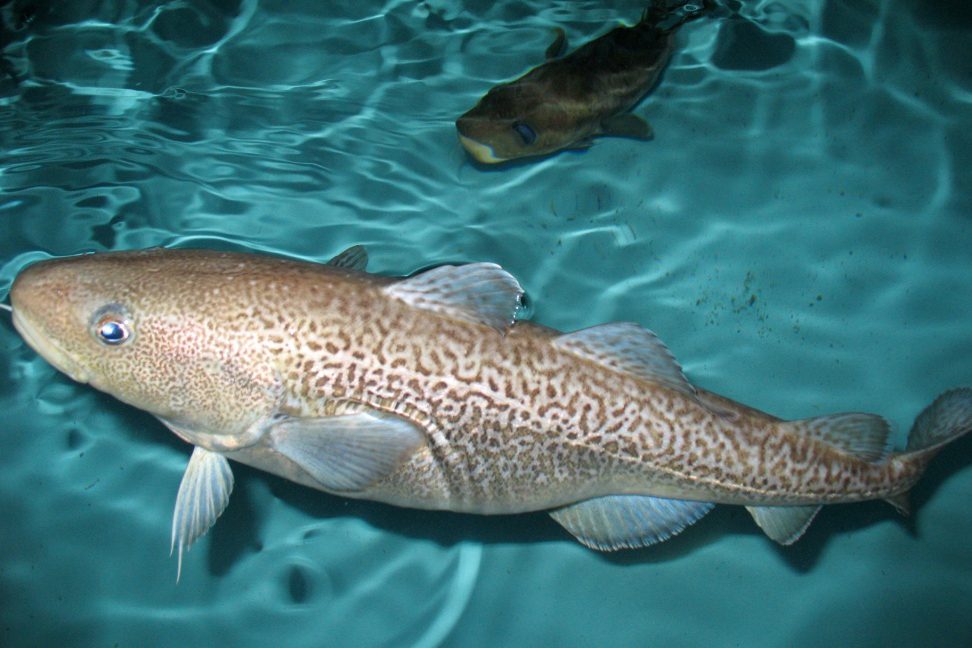
Warming waters in the southeast Bering Sea and Gulf of Alaska ecosystems can boost the metabolic demand for food of young Pacific cod. But what if, due to warming ocean waters, there is no prey to be found?
If there are no prey available for that first feeding, the young fish faces starvation, says Ben Laurel, a research fisheries biologist with the Alaska Fisheries Science Center at Oregon State University’s Hatfield Marine Science Center in Newport, Oregon.
For young Pacific cod, that first feeding is a matter of life or death. Cod larvae find nourishment in a yolk sac after hatching, but once that sac is depleted, they must find food within days or die. A NOAA Fisheries study led by Laurel looked at how temperature shifts impact those first feedings of Pacific cod larvae in these two ecosystems, and concludes that warming waters increase the risk of prey mismatch and starvation for the young fish.
The match-mismatch hypothesis, first proposed in 1969, suggests that the time match between larval first feeding and production of their zooplankton prey is the key to their survival, the NOAA report said.
Very few young fish, in fact, survive their first year, and small changes in first-year mortality have a big influence on the number of adult fish emerging from that cohort.
Pacific cod release all their ripe eggs at one time in the spring, and this very narrow window for first feeding could put them at higher risk for prey mismatch. Changing environmental conditions brought on by global warming could lead to “super mismatch events” with low survival of the young fish across an entire region, Laurel said.
When mismatched prey timing and increased metabolic demand line up, it can be pretty disastrous, Laurel said. The more scientists understand, the more effectively they can forecast events and help fishing communities prepare for them, he said.
While researchers have studied the relationships between temperature and marine populations for years, what they don’t always know is how temperature fluctuations drive change. Laurel’s focus in his more than 20 years of research has been how Pacific cod respond to rapidly changing environmental conditions in Alaskan waters.
Following the marine heatwave known as “The Blob” from 2014-2016, Alaska Fisheries Science Center scientists documented a steep drop in adult cod numbers. Those extensive losses prompted new efforts to understand factors critical to the survival of young cod.
Laurel notes that they started their research when cod populations were healthy both in the Bering Sea and Gulf of Alaska. Experiments were conducted on the impact of temperature changes on larvae just to learn more about the biology of these fish. When the marine heatwave hit, those observations took on new importance, Laurel said.
The researchers collaborated to look at larval survival at different temperatures with satellite remote-sensing estimates of chlorophyll and sea surface temperature, comparing Gulf of Alaska and Bering Sea ecosystems.
They found that warming increased the risk of prey mismatch for cod larvae through changes in the timing of prey production and larval metabolic demands, and that projected warming in the future will likely increase prey mismatch vulnerability on cod larvae. They found that the effect of the heatwave on potential survival of cod larvae was greater in the Gulf of Alaska than in the Bering Sea, due to mismatch drivers being fundamentally different in the two ecosystems.
Laurel noted that spring plankton production in the Bering Sea is tied to the timing and extent of sea ice cover, which fluctuates widely from year to year.
“But cooler temperatures in the Bering sea buffer food demands on fish larvae so they are not as sensitive to timing,” he said.
In the Gulf of Alaska, by comparison, prey production timing historically has been less variable, but warmer temperatures mean larvae are more sensitive to variability. Larvae consume the yolk sac nourishment quicker and have less time to find food once it is gone.
“The story really shows how warming can quickly unravel an ecosystem through intertwined processes,” he said.
Understanding the impact of changing environmental conditions on young cod now provides more information into their recruitment potential, which can be used to improve ecosystem-based fisheries management in Alaska, he said.





